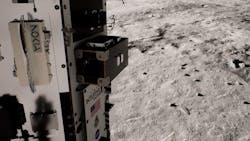Intuitive Machines and Nokia to deploy first cellular network on the moon
HOUSTON - Intuitive Machines in Houston and Nokia in Espoo, Finland have announced the successful integration of Nokia’s Lunar Surface Communication System (LSCS) into the Athena lunar lander, which is scheduled to travel to the Moon’s south pole as part of Intuitive Machines’ IM-2 mission. The mission will attempt to establish the first cellular network on the Moon.
The LSCS, developed by Nokia Bell Labs, was installed on one of Athena’s upper carbon-composite panels following testing and validation. Intuitive Machines engineers incorporated several safety features to ensure the network survives the journey, withstands launch and landing stresses, and operates effectively on the Moon.
Additional components of the LSCS have been installed on two lunar mobility vehicles: Intuitive Machines’ Micro-Nova Hopper, named Grace, and Lunar Outpost’s Mobile Autonomous Prospecting Platform (MAPP) rover. Once on the lunar surface, these vehicles are designed to establish connections with the network on Athena, enabling mission-critical communications.
The LSCS uses 4G/LTE cellular technology adapted for the lunar environment. It will support surface connectivity between the lander and vehicles, allowing for high-definition video streaming, telemetry, and command-and-control communications. Data collected via the network will be relayed back to Earth using Intuitive Machines’ direct-to-Earth transmission service.
"We intend to prove that cellular technologies can provide the reliable, high-capacity, and efficient connectivity needed for future crewed and uncrewed missions to the Moon and eventually Mars," said Thierry E. Klein, President of Bell Labs Solutions Research at Nokia. "Cellular technology has irrevocably transformed the way we communicate on Earth. There’s no reason it can’t do the same for communications on other worlds."
The Micro-Nova Hopper is designed to explore permanently shadowed lunar craters and test new sensor technologies that could identify resources such as water ice. It will scan for hydrogen, a key indicator of ice deposits, and transmit the data over Nokia’s network to Athena, which will send it back to Earth. The MAPP rover will map the Moon’s surface and collect environmental data during a multi-day exploration of the south pole region.
Related: NASA offers up to $200 million to help push new technologies to market
The LSCS and Micro-Nova Hopper were developed under NASA’s Tipping Point initiative, which supports industry-driven technologies for commercial space capabilities and future NASA missions.
"We believe delivering Nokia’s 4G/LTE system to the lunar surface is a transformative moment in the commercialization of space and the maturity of the lunar economy," said Intuitive Machines CEO Steve Altemus. "Whether it’s Nokia connecting surface assets or Intuitive Machines transmitting that data back to Earth, these innovations represent foundational capabilities for the Artemis generation."
The Athena lander is slated for launch no earlier than late February from NASA’s Kennedy Space Center.
